How to Travel to Iceland
There are plenty of reasons why Iceland is one of the hottest travel destinations: it’s home to some 30 active volcanoes, steaming hot springs, and bubbling geysers, to name a few of its natural attractions. The Land of Fire and Ice is also famous for specific sites, like the largest glacier in Europe by volume and crystalline ice caves that can only be explored in the winter. And that’s to say nothing of the flickering Northern lights above.
While it’s hard to plan a bad trip to Iceland, it’s easy to get caught up in the logistics. For a stress-free trip to see Iceland’s wonders, consult our comprehensive guide as you plan your trip.
When to Go
What you see and do in Iceland will be almost entirely determined by the time of year you visit.
Winter, which goes from October through the beginning of March, brings with it short days and lots of precipitation. But despite its name, Iceland doesn’t get unbearably cold. Temperatures will hover around freezing, or 32 degrees Fahrenheit. The lack of daylight can be troublesome (during the solstice, in December, daylight is limited to less than four hours), especially for travelers venturing far away from Reykjavik and the capital’s well-lit streets. But the impermeable darkness also means excellent conditions for viewing the Aurora Borealis, and major savings. Airfare can drop by a third during the off-season, and discounts can be found on lodging, food, and activities, too. You’ll also find much thinner crowds at some of the country’s most popular attractions.
Summertime can offer travelers nearly 21 hours of daylight, with the sun rising as early as 2:55 a.m. near the end of June and setting just before midnight. Moderate temperatures, typically in the 50s and 60s, can be enjoyed from May until September. July and August are the peak tourist months. Extra daylight for sightseeing is an obvious draw for Iceland-bound travelers, but visiting in the winter shouldn't be discounted.

How to Get There
Icelandair and WOW Air, the two Iceland-based carriers, are your best bet for direct and affordable flights to Iceland. WOW Air is known for selling $99 one-way tickets to Iceland from major U.S. hubs, though recently, the fares have dropped to as little as $70. Travelers based in the United States can catch flights from San Francisco, Los Angeles, Chicago, Pittsburgh, Washington, D.C., Miami, New York, and Boston.
For a full-service experience, Icelandair offers travelers complimentary soft drinks, tea, and coffee; a free checked-bag, carry-on, and a personal item; and includes in-flight entertainment. While tickets are more expensive than WOW, the airline has developed a reputation for its free stopover program, which lets you spend up to seven nights free in Iceland. They even offer a Stopover Buddy: a local who will take you to see the country’s greatest hits, free of charge.
U.S.-based travelers don’t need a visa to visit Iceland, as it’s a part of the Schengen Agreement (a group of 26 European countries with visa and passport-free borders). You will, however, need a passport that’s valid for at least three months after the date of your departure.

Getting Around
All international flights land at Keflavík International Airport, which is a 40-minute drive from the capital, Reykjavik. Travelers can take the Flybus airport shuttle to Reykjavik Bus Terminal for 2,500 ISK ($21.50) or spend a bit more for the Flybus+ option, which will deliver you directly to your hotel or Airbnb. Cabs also frequent the route between the airport and downtown Reykjavik, and will cost you about 15,000 ISK ($130).
Beginning in February 2017, travelers have the option to catch a domestic connection from Keflavík Airport, which had previously only served international flights. Three times a week, travelers can fly to the northern city of Akureyri, which can be difficult to reach when heavy snowfall and ice block the only road to Iceland’s second-most populated area.
Unless you’re planning to remain in Reykjavik, driving is your best option for exploring Iceland. In addition to major rental companies like Hertz and Budget, travelers should consider Green Motion (this European rental agency specializes in eco-friendly vehicles) and Campervan Iceland — a great option for saving money while still seeing all of the vast island.
You’ll be driving on the right side of the road in Iceland, but travelers should note that the speed limit is in kilometers, and gas is an extremely expensive import. On average, a gallon costs about 194 ISK (roughly $7.50).
Regardless of the time of year, travelers should spend more for a sturdy vehicle with four- or all-wheel drive. While the winter brings ice and snow (and the need for studded snow tires) summer can bring sandstorms. Drivers should be aware that, year-round, the wind can be incredibly forceful.
What to Pack
Regardless of when you’ve planned your trip, pack for all four seasons of the year — and plan to use every single piece of clothing. Leave your fancy garments behind: especially if you’re traveling on a budget airline, you’ll want to save room in your pack for what matters most. Don’t leave home without a T-shirt, thermal base layers, a rain jacket, hiking boots, a swimsuit or two, a hat, sunglasses, waterproof hiking pants, gloves, and other jackets. If you expect to do a lot of hiking, particularly in the winter, pack a headlamp. Travelers bound for Iceland in the summer should bring an eye mask to help with falling asleep while the sun is still up.

What to Do in West Iceland
Snæfellsnes Peninsula
A road-trip around Iceland’s Snæfellsnes Peninsula could be considered a vacation in and of itself. It’s one of the country’s most remote destinations, where sheer cliffs are lashed by the North Atlantic and craggy lava fields are blanketed in moss and fog. Highlights along the way are Stykkisholmur — a remote fishing village with such odd attractions as a Library of Water and Norwegian House museum.
Cave Víðgelmir
Closer to Reykjavik, adventurous travelers can explore a lava tube in the Hallmundarhraun lava field. Called Víðgelmir, visitors can book a tour to explore the 5,250-foot-deep cave. Guides offer itineraries for all ages and levels of fitness.
Into the Glacier
Hailed as the world’s largest man-made ice tunnel, Into the Glacier stretches for more than 1,800 feet beneath Langjökull. Inside, visitors will find a spacious cave in the center of the ice cap, and even a chapel carved from ice and snow.
Where to Stay in West Iceland
Hotel Budir
A 17th-century trading post-turned cozy winter retreat, Hotel Budir has the most exceptional views of the Snæfell Glacier and Atlantic Ocean. Nurse a glass of whiskey in front of the lounge’s fireplace, or visit the iconic black church on the edge of the property. You’ll sleep soundly knowing an overnight concierge will wake you up if the Northern Lights make an appearance.
Hotel Egilsen
With only 10 cozy rooms, it’s easy to feel at home at Hotel Egilsen. Everything here is made by hand, including the bed quilts and the breakfasts (expect local lox, skyr smoothies, fresh-baked breads, and hand-crushed granola). Solo travelers should book one of the loft rooms in the attic.
Hotel Husafell
One of the country’s newer properties, Hotel Husafell opened in 2015, and is the perfect location for travelers interested in Into the Glacier and Víðgelmir Cave tours. It’s also one of the most upscale properties in Iceland, with paintings by local artist Páll Gudmundsson and on-site geothermal baths. The restaurant is superb — as is the dedicated gin and tonic menu.
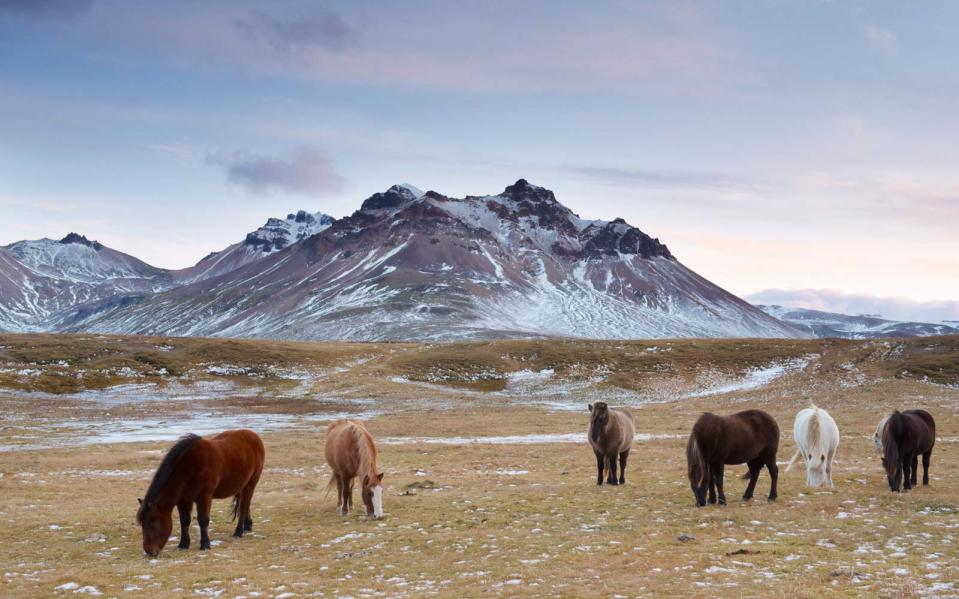
What to Do in East Iceland
Wild Reindeer Safari
Still considered one of Iceland’s most untouched corners, travelers who make the journey to the island’s easternmost coast will encounter few (if any tourists) and have the opportunity to embark on a reindeer safari. To this day, the nation's 6,500 wild reindeer — all of which descended from the original 35 brought from Norway in 1781 — live only in East Iceland. Travel East Iceland's specialized guides can help you track the elusive creature, with tours departing from Egilsstaðir. Binoculars and fried Icelandic pastries, kleinur, are provided.
The Eastfjords
Uncrowded and virtually untouched, Iceland's Eastfjords are popular with locals who enjoy adrenaline-worthy kayaking. Highlights include Fossardalur (also known as Valley of the Waterfalls) and the dramatic cliffs of Berufjordur. Farther northeast is the quaint village of Seydisfjordur. Seydisfjordur is also something of an artist’s colony, with plenty of intimate galleries and live concerts inside the town’s pale blue church.
Deep Sea Fishing
Head out onto Breiddalsvik harbor for an afternoon on a traditional oak fishing boat. Anglers can catch fresh cod while watching dolphins, seals, and puffins plying the waters. Later, you can have your bounty prepared for dinner.
Where to Stay in East Iceland
Hotel Bláfell
In the tiny village of Breiðdalsvík, amongst the fjords and black sand beaches of East Iceland, is the 46-room Hotel Blafell. Rooms are either minimalist and Scandinavian in design, or inspired by rustic log cabins. All guests enjoy complimentary breakfast and access to the property’s fireplace lounge and library.
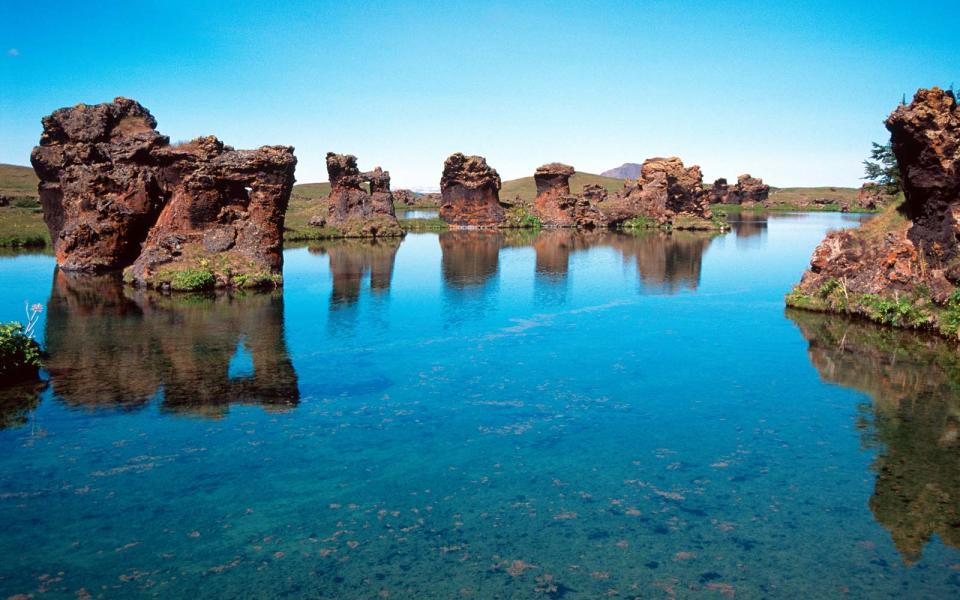
What to Do in North Iceland
Lake Myvatn
If you’re a fan of Game of Thrones, you’ll instantly recognize Lake Myvatn. (The snow-covered wetlands served as the dramatic backdrop for a romantic scene between Jon and Ygritte.) Guests venturing to the Northern crest of Iceland will be rewarded with hot spring baths at Hverir and Krafla, and the deep blue Myvatn Nature Baths.
The Arctic Henge
Iceland’s answer to Stonehenge may look ancient, but the project was started as recently as 1996. The monument celebrates the region’s Nordic heritage, and entices tourists to stray from the well-trod Ring Road. Visit during the solstice, when the angular towers frame the midnight sun.
Whale Watching
Stop in Husavik, the island’s self-proclaimed whale watching capital, for a chance to watch migrating humpback whales during the warm summer months. There’s also a whale museum and a research station for biologists in the town.
Where to Stay in North Iceland
Deplar Farm
Tucked away in a valley, Eleven Experience’s utterly opulent mansion is the most upscale property in Iceland. Expect more of a vacation home vibe than a true hotel experience: there’s no reception desk or an on-site restaurant. Visit in March for the region’s spectacular (and spectacularly short) heliskiing season.
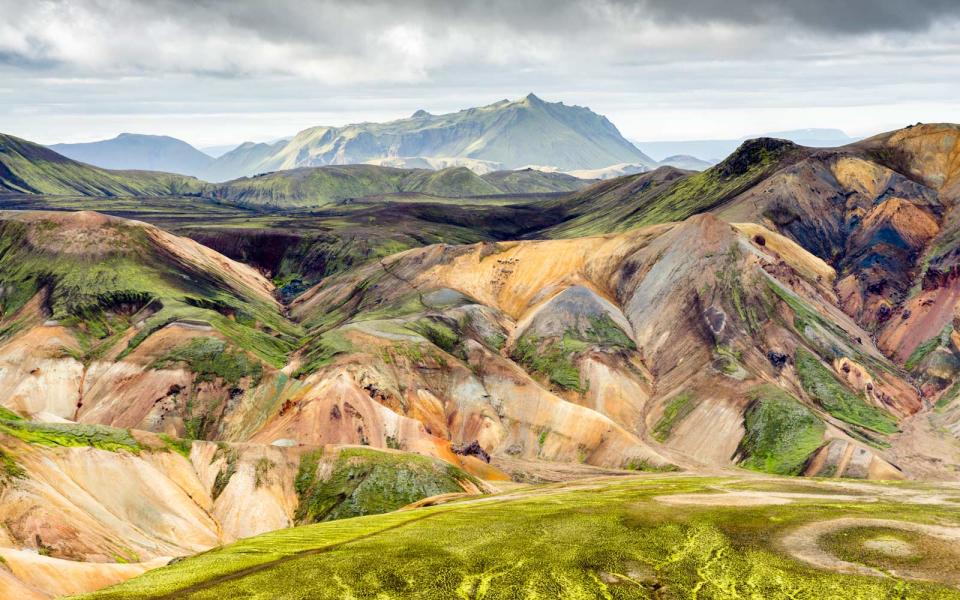
What to Do in South Iceland
Jokulsarlon Glacier Lagoon
Head all the way southeast to see the impossibly blue Jokulsarlon Glacier Lagoon, where icebergs float and break up on the black-sand shores like glittering diamonds. Visitors can also explore the famous ice caves and trek along one of Europe’s largest glaciers in Vatnajokull National Park. Ask Ice Guides to take you to see the waterfall crystal cave.
Thingvellir National Park
The historic site of the world’s first parliament, Thingvellir is now a national park and UNESCO World Heritage Site. Here, adventurous travelers can go snorkeling in between two tectonic plates in the 35 degree water of the Silfra Fissure.
The Golden Circle
Loop around this 160-mile-long tourist route to see some of Iceland’s most iconic sites: the sulfurous hot springs of Geysir (it’s the Stokkur geyser that erupts with a 90-foot plume like clockwork); the glacier-fed waterfall, Gullfoss; and the volcanic Kerid crater, which is filled with electric blue water and best seen in summer, when the snow melts to reveal red volcanic rock.
Thorsmork
Book a tour with Midgard Adventure, who can take you through this spectacular hiking spot in their indestructible super jeeps. Along the way, you might also stop at Skogafoss and Eyjafjallajökul. Thorsmork is also the entry point to the Landmannalaugar hike, which crosses the kaleidoscopic rhyolite mountains. Travelers can even spend the night at Midgard's new hostel.
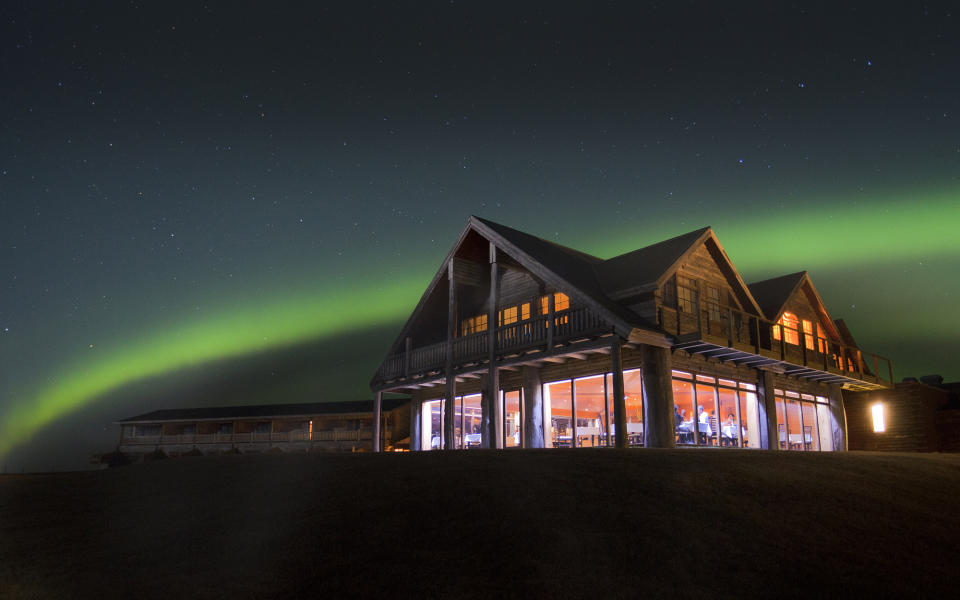
Where to Stay in South Iceland
Hotel Ranga
Northern Lights seekers should book a stay at the upscale Hotel Ranga, which has an inviting log cabin look and feel. The geothermal hot tubs are the perfect place to enjoy the light show after a veritable feast in the restaurant (it may very well be the best meal you have on your trip).
ION Adventure Hotel
With its dramatic structure set on stilts over the rugged landscape, ION Adventure Hotel is another popular spot for Northern Lights viewing. Its proximity to a geothermal plant means the smell of sulfur is hard to avoid, but the 45 rooms are clean, sleek, and inviting.
What to Do in Reykjavik
Reykjavik Public Pools
No, you can’t visit Iceland without visiting the Blue Lagoon. But for only $5, visitors can enjoy the mineral-rich bathing pools preferred by locals. There are a variety of different facilities, but all of them have 108-degree waters.
Hallgrimskirkja
Take the elevator to the top of this instantly recognizable church, which was erected on the highest point in the capital, for views over Reykjavik. It’s often celebrated as the first example of a national Icelandic architecture — and you can see similar variations in churches across the country.
National Museum of Iceland
Discover the island’s rich history, from the Vikings who settled the windswept territory to contemporary times, at this small but comprehensive museum. Don’t miss the Valthjófsstadur Door: a medieval artifact engraved with scenes from the knight’s tale, Le Chevalier Au Lion.
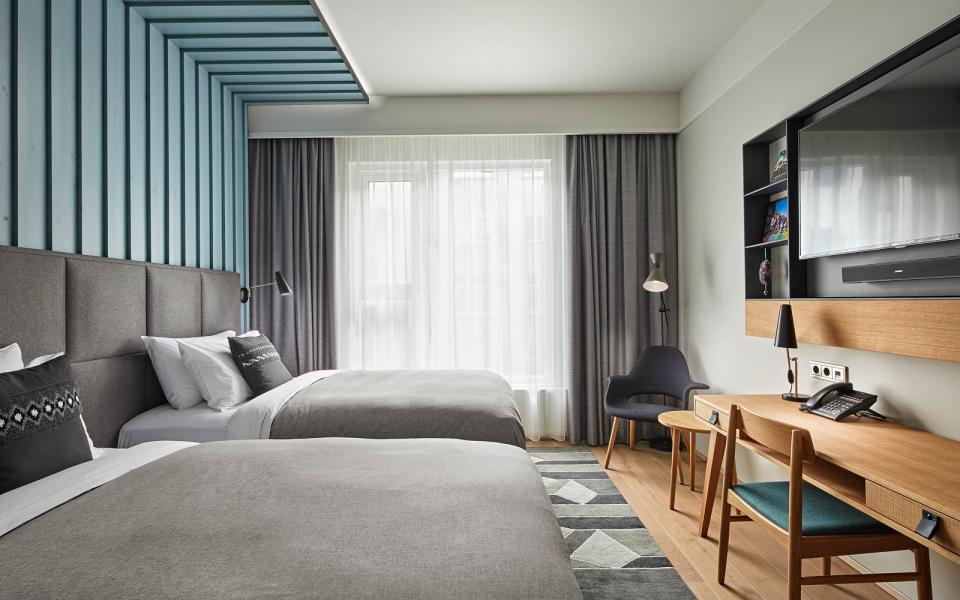
Where to Stay in Reykjavik
Canopy By Hilton Reykjavik
Canopy, Hilton’s new lifestyle brand, opened its first outpost in an enviable spot in the city center on Hverfisgata Street. Every evening, guests can mingle over complimentary wine and beer tastings, while mornings are best spent over the almost excessive breakfast buffet. Rooms are modern and inviting, finished with shades of blue and gray. Don’t forget to play the Reykjavik Music Box before drifting to sleep.
Alda Hotel
Upmarket, but still affordable, Alda Hotel is done in shades of white and gray, with pops of color to add contrast. Request a room with a private balcony and a sea view. All guests enjoy access to the hotel’s gym and sauna.
Icelandair Hotel Reykjavik Marina
Sound familiar? That’s because Icelandair doesn’t just operate an airline. The national carrier also owns several hotels in Iceland. This hotel along the old harbor is considered one of the best, with a playful nautical theme and excellent in-house bar, Slippbarinn.

Where to Eat and Drink
Dill
At this tiny space in Reykjavik (don’t arrive without a reservation), opt for the full seven-course feast. Expect such distinctly Icelandic provisions as Arctic char with fennel, pear with almond and birch, and dung-smoked trout.
3 Frakkar
Since 1989, Chef Úlfar Eysteinsson has been serving Reykjavik diners Iceland’s most unique specialties. Come here for roast whale with apples and sunflower seeds, Icelandic shark, horse tenderloin with potato wedges and pepper sauce, and even smoked puffin breast.
Fridheimar Farm
Travelers tracing the Golden Circle route should stop at Fridheimar for all-you-can-eat tomato soup with house-baked bread. In the adjacent greenhouse, guests can snip herbs to garnish their lunch.
Laundromat Cafe
For breakfast, lunch, or brunch, this Reykjavik outpost of a Danish cafe serves comforting food and coffee alongside classic board games (chess, cards, Yahtzee). Order the Icelandic smoked trout on a poppy seed bagel, or try the signature Dirty Brunch: scrambled eggs, sausage, bacon, roasted tomato, fried potatoes, brie, yogurt with muesli, pancakes, and more. Consider sharing with your tablemates.
Kaffibarinn
Beneath the London Tube sign is the entrance to Kaffibarinn: a coffee shop by day and dance club by night. Even if you aren’t particularly interested in hearing a house music set or checking out Reykjavik’s hottest DJs, it’s a must-see spot for travelers interested in cracking open a can of Viking lager.
Bergsson Matthus
Now open until 10:00 p.m., Bergsson Mathus is an inviting space that serves breakfast, lunch, and dinner. The menu changes every day, but might include avocado toast with smoked salmon, lentil cream soup, or a hearty spinach lasagna.
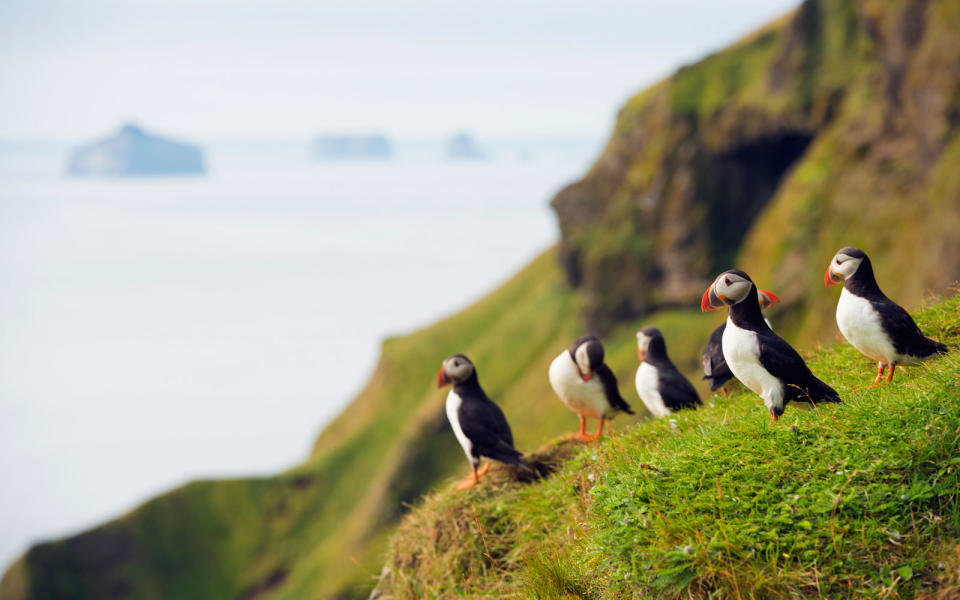
Day Trips From Iceland
Westman Islands
Off the coast of South Iceland, travelers can reach the Westman Islands by either ferry or a 20-minute flight from Reykjavik. Consider making the trip in the spring or summer, when the island’s famous puffin colonies will be nesting. They’re partial to Stórhöfði, which is considered the windiest place on Earth. Other highlights for a day trip include driving to the center of the Eldfell volcano and snapping a photo of Elephant Rock.
Flatey Island
Considered something of a secret even by Icelanders, this mile-long rocky outpost in Breiðafjörður Bay is the largest of 3,000 similar rocky outcroppings. Take the ferry over in the summer, when Hotel Flatey is open for business and the isle is brightened by Arctic blooms. Even if you don’t spend the night, visitors can punctuate 21-hour-long days by retreating to the property’s downstairs restaurant, which hosts live music at night.

